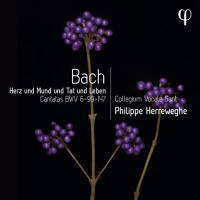Texte paru dans: / Appeared in: |
|
|
Outil de traduction |
|
|
From two initial releases on Virgin Classics in the early 1990s, a dozen or so since for Harmonia Mundi and recently a handful on PHI, Philippe Herreweghe’s programming of individual Bach cantatas has always seemed somewhat serendipitous. One suspects, like Sigiswald Kuijken’s seasonal choices in his mini-cycle, personal preference plays a significant part. The last release pitched the exuberant Trinity cantata, No 45, as a prelude to the Trauer Ode (6/21) and yet it was not as eccentric as one might have imagined; it successfully identified Herreweghe’s strategy of exposing rhetorical variety at the heart of Collegium Vocale’s luminescent engagement with Bach.
Following on from that 2021 release, these three fine Leipzig cantatas are given deeply considered, refined and consistent performances. The headline is the famous Cantata No 147, whose ambitious bipartite structure (each part ending with the ubiquitous ‘Jesu, joy of man’s desiring’) reveals Bach’s eagerness to impress in his early Leipzig days. Herreweghe takes the Feast of the Visitation with utmost seriousness, not least in the way that in both the arias and recitatives, the instrumentalists and singers are conjoined wonderfully to uncover the imagery. In the opening movement, the solo trumpet and sopranos dance round each other giving exultant witness, while in the second recitative we hear John jumping in Elisabeth’s womb with two unambiguously descriptive oboes da caccia. The care taken in the recitatives to prepare for the centrepieces of each work – in this case, a ravishing account of ‘Bereite dir, Jesu’ sung by Dorothee Mields and with Christine Busch’s violin obbligato of concurring discipleship – is partly achieved by Herreweghe’s accentuation of words, patiently uncovering their meaning within the careful punctuation of the continuo line. No one can fail to understand our place in the journey.
If No 147 is a tableau of extended richness, not least in outstanding singing from all the soloists, both Was Gott tut, das ist wohlgetan (No 99) and Bleib bei uns (No 6) are afforded equally fine readings. The opening chorus of the former is an unarguable masterpiece which Herreweghe acknowledges with meticulous attention to gesture, balance and text, and an infectious release. Bach scholar Michael Maul suggests that this extended concertino of violin, flute and oboe d’amore, around which the hymn tune appears intermittently, might depict carefree humanity under God’s protection, and such speculation here seems entirely plausible.
It’s the kind of arresting conceit that Bach sought to reflect in the chorale setting ‘Ach, bleib bei uns’ from No 6, where eventide and resignation to death find a contented peace in the roulades of a solo violoncello piccolo. The slightly demure presentation of the chorale in this movement is a touch underwhelming but soon fades in the memory with Guy Cutting’s beguiling and attentive singing of the final aria. It caps another exceptional Bach recording from an ensemble and director who just keep giving. Jonathan |
|




